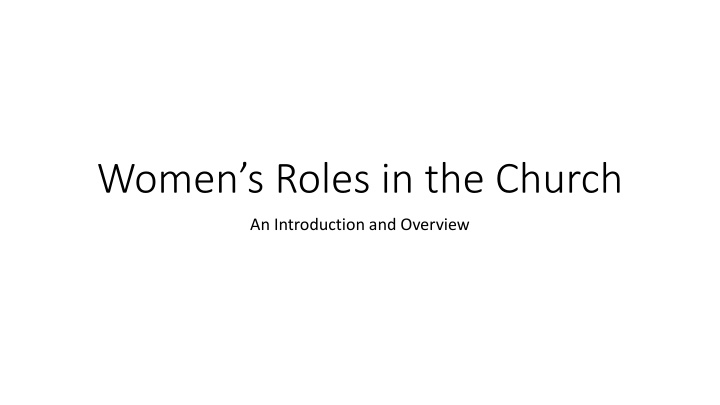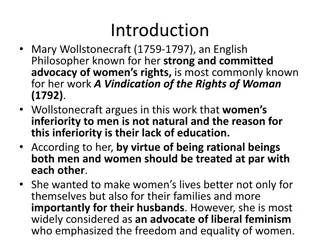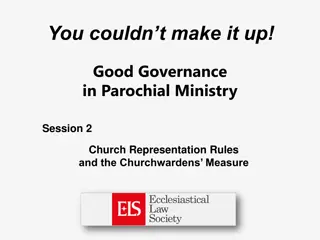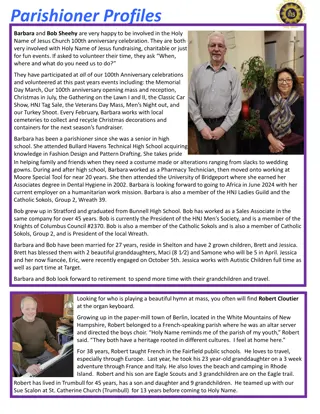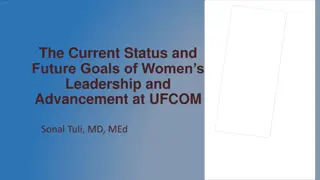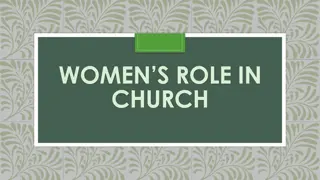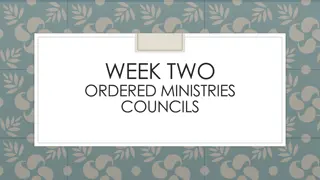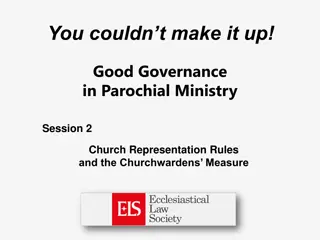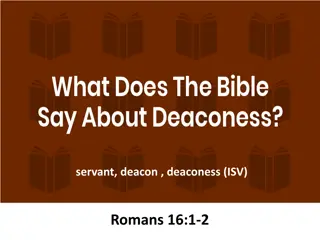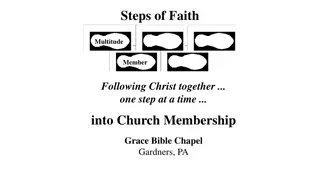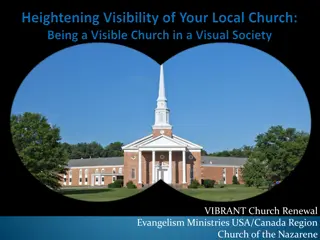Women's Roles in the Church: An Introduction and Overview
The discussion within the church on various important topics like women's roles, racial issues, and LGBTQ matters prompts a study of Hermeneutics for better understanding and interpretation of Scripture. Exploring different hermeneutical approaches reveals insightful perspectives on how to approach the Bible in its historical and cultural context. The significance of studying the context of biblical teachings, especially regarding women's roles, is emphasized without compromising core beliefs. Reflecting on Genesis reveals the equal value of both men and women as image bearers of God.
Download Presentation

Please find below an Image/Link to download the presentation.
The content on the website is provided AS IS for your information and personal use only. It may not be sold, licensed, or shared on other websites without obtaining consent from the author.If you encounter any issues during the download, it is possible that the publisher has removed the file from their server.
You are allowed to download the files provided on this website for personal or commercial use, subject to the condition that they are used lawfully. All files are the property of their respective owners.
The content on the website is provided AS IS for your information and personal use only. It may not be sold, licensed, or shared on other websites without obtaining consent from the author.
E N D
Presentation Transcript
Womens Roles in the Church An Introduction and Overview
Two years ago, Fenton and the Elders Group began discussing important topics that face our church today such as: WOMENS ROLD IN THE CHURCH RACIAL ISSUES LGBTQ ISSUES We realized that before diving into the Role of Women in the church, having a better way of studying and understanding Scripture would need to be the first step in the process. This began our study of Hermeneutics Defined simply as the interpretation of language, whether written or spoken. We learned that in our study of the Bible we approach hermeneutics with several basic tools that include: Blueprint The literal meaning of a scripture A blueprint hermeneutic reads the Bible looking for a timeless rule-prescribed pattern that obligates all churches in the future. It takes the command out of the story. It can take Scripture out of context. Like a Contract. Theological Hermeneutic this approach reveals the heart of God expressed in the command, example or inference. In the story what is the heart of God? It is Relational. Trajectory Hermeneutics is approaching the Scripture looking to see where God is leading us; what is the progression? Where are we headed?
As we study out the Womens Role in the church, remember what we have discussed about the importance of understanding the Bible in the context of how, when, to whom and where it was written: It was written over 2,000 years ago It was written in a very different culture It was written by Jewish authors It was written to a very Jewish audience It was not written to US but it was written for US and we can learn from what the Bible teaches. In the Epistles/Letters it is very much like listening to one side of a phone call. We do not have the entire story available to us. The letters were very situational. They were written in response to some issue or event that had happened to that group of Christians in the church.
The womens role in the church is important but it is not a salvation issue. Let s keep things in perspective. Opinions Doctrinal Practices Dogma Jesus Core Beliefs
In The Creation Story Genesis 1 v26-27 says, Then God Said, Let us make mankind in our own image, in our own likeness, and let them rule over the fish of the sea and the birds of the air, over the livestock, over all the earth, and over all the creatures that move along the ground. So God created mankind in his own image, in the image of God he created them; male and female he created them. WE ARE ALL MADE IN GOD S IMAGE, BOTH MEN AND WOMEN, WE ARE BOTH GOD S IMAGE BEARERS.
Women have been called upon many times to perform major roles in serving Gods people. Exodus 15: 20-21, Numbers 12: 1-5, Micah 6: 1-8 (role of Miriam) Judges 4:5 (role of Deborah) 2 Samuel 14: 1-20; 20: 14-22 (noting the role of women as sages in Israel) 2 Kings 22: 14-20; 2 Chronicles 34: 19-28 (role of Huldah) Nehemiah 7: 67; 2 Samuel 19:35; Ezra 2:65 2 Chronicles 35:25 (noting the role of women as Levitical singers during worship) Esther 9:29-31 (the role of Queen Esther) Psalm 68 (noting the role of women as heralds) Joel 2:28 (including Joel s prophesy about the future restoration of Israel when God said I will pour out my spirit on all people. Your sons and your daughters will prophesy, your old men will dream dreams. )
In determining the Role of Women in the Church there are three basic lines of thought in the church. No Participation; as Paul is quoted in the book of Corinthians 14:34 Woman should remain silent in the churches. They are not allowed to speak, but must be in submission, as the law says. Limited Participation: women can serve in certain compacities in the church, children s ministry, women s ministry, and various other roles in the church. Full Participation: women should be aloud to do any role that men can do and there should be no difference. As we study the Women s Role in the church it is important that we consider and try to answer these questions: 1. What worship and leadership roles for women in the church are supported by the Bible? 2. What changes, if any, should Cornerstone make regarding the role of women in the church at this time? 3. What additional topics of study and discussion are recommended in related areas at Cornerstone? Over the next number of weeks and months, however long it takes, through the study of the Scripture and the use of Hermeneutic tools, we are going to decide what our belief and practice is going to be for the Role of Women in the church at Cornerstone.
As mentioned already, a Scripture that we are all familiar with is I Corinthians 14:34-35 Paul tells the church in Corinth Women should remain silent in the churches. They are not allowed to speak, but much be in submission, as the lol says. If they want to inquire about something, they should ask their own husbands at home; for it is disgraceful for a woman to speak in the church. If we were to apply a Blueprint hermeneutic, we might take this literally and this would be applying a no participation position. Should this command given to the church in Corinth be a rule for all churches for all time? Women Serving God, John Mark Hicks, My Journey in Understanding Their Story in the Bible Blueprint or Theological Hermeneutics p.71
Lets take a closer look at Corinth and what was happening there at the time Paul wrote this letter. What was unique about the history and geography of the City of Corinth? What was culture like in this Greco-Roman culture? What was the City of Corinth known for? What was going on in the church in Corinth that Paul was addressing?
The ancient City of Corinth is located in Greece along the Mediterranean Sea
Corinth The ancient Greek city of Corinth was destroyed by the Romans in 146BC but was rebuilt a century later by Julius Caesar. In the time of Paul, Corinth was a busy Roman trading City on the narrow strip of land between the Ionian Sea and the Aegian Sea. It had two harbors, Lechacum on the Gulf of Corinth to the west and Cenchraca on the Aegian Sea to the east. It made huge profits by taxing cargoes that were transported overland between the two ports to avoid the dangerous waters around the Peloponnese. Ships would unload their cargos on the one side of Corinth and transport their goods over land 4 miles and reload on another ship on the other side of Corinth. Because of its unique location and importance to shipping and trade, Corinth became prosperous, diverse, modern, and mostly pagan. The pagan converts were known for many sins but especially sexual ones. Their culture was used to temple prostitutes and other depraved customs. The church in Corinth was a hot mess.
The culture and politics of Corinth during the time of Paul The View from Paul s Window, Paul s teachings on Women, Jeannie Shaw (biography) p. 49-53 We don t have the whole story of what was going on in Corinth at the time of Paul s I and II Corinthians.
In Conclusion: In the BEMA Podcast, in one of Marty Solomon s initial podcasts he talks about how we as Americans have a very western mindset. We see things through our lens that is influenced by our culture, our history, our family, politics and surroundings. The Bible was written by prophets and authors who were of a very Eastern mindset, the Scripture was written to an audience with Eastern views, culture, history, family ties, politics and surroundings We at Cornerstone are on a journey of discovery to deepen our understand of God s word and God s will for our lives. As westerners, we like to have it all figured out and we are not comfortable with mystery or ambiguity. By understanding our own biases and perspectives and learning to correctly apply these basic biblical hermeneutic tools of how to read the Scripture framed in the context of who it was being written to and why it was being written, it is our hope that we may all learn to adjust our thinking about the Role of Women in the church and other important cultural issues that we as a body of believer's wrestle with today.
